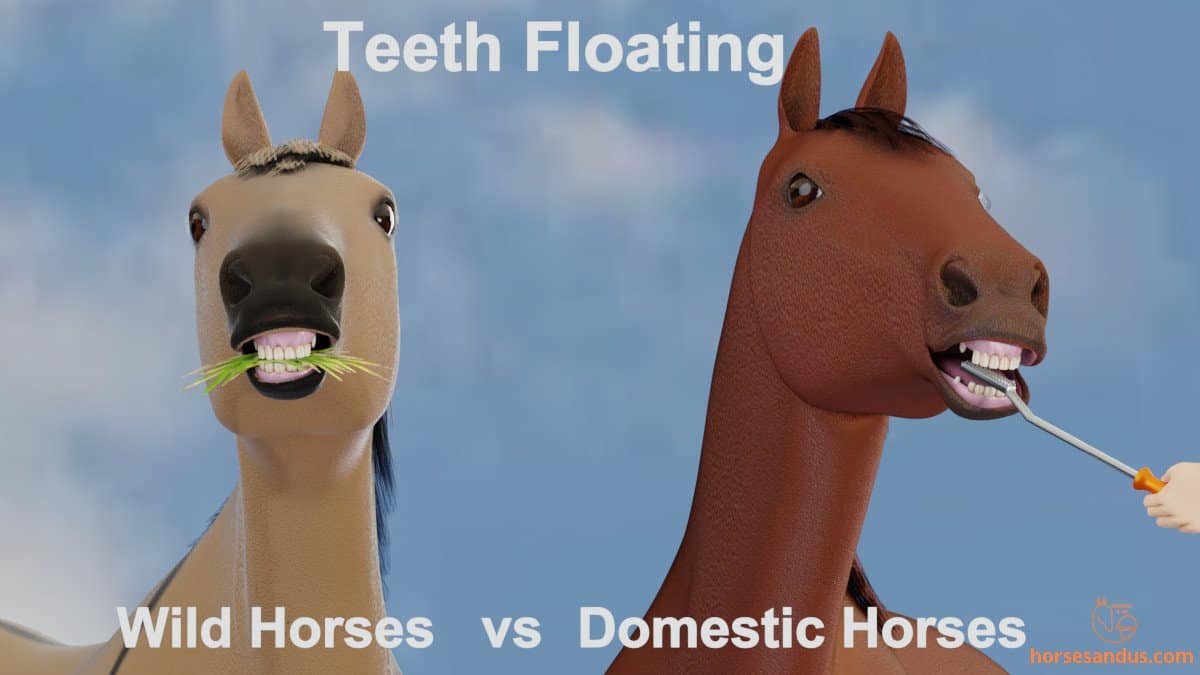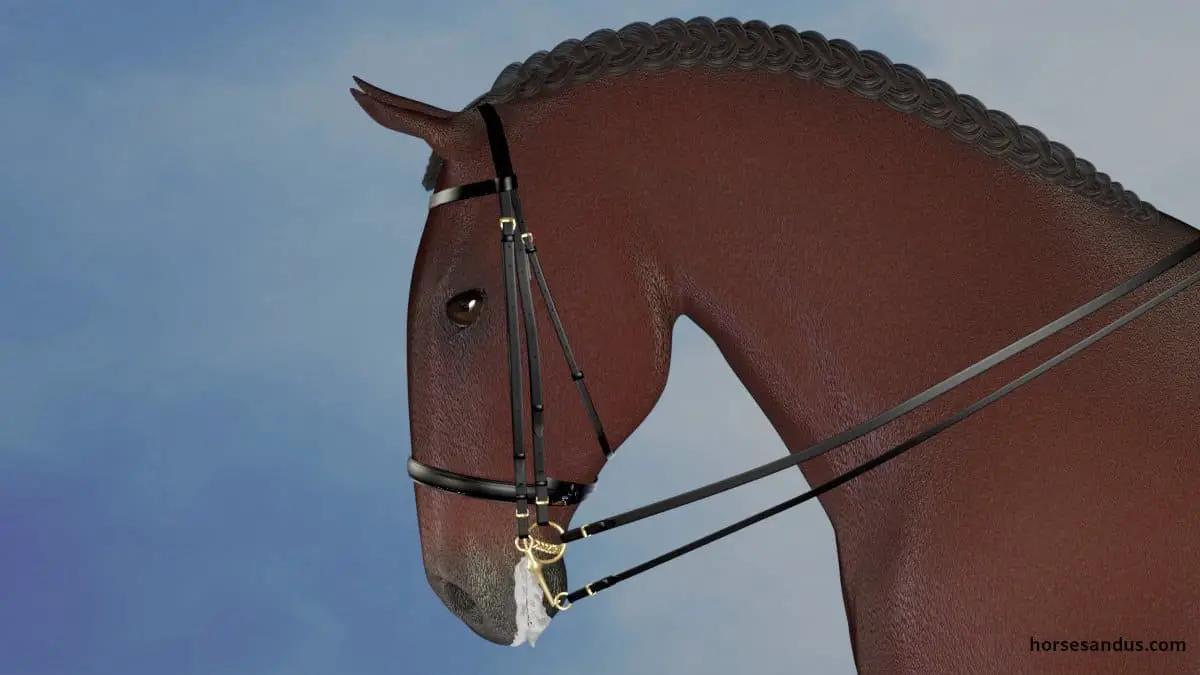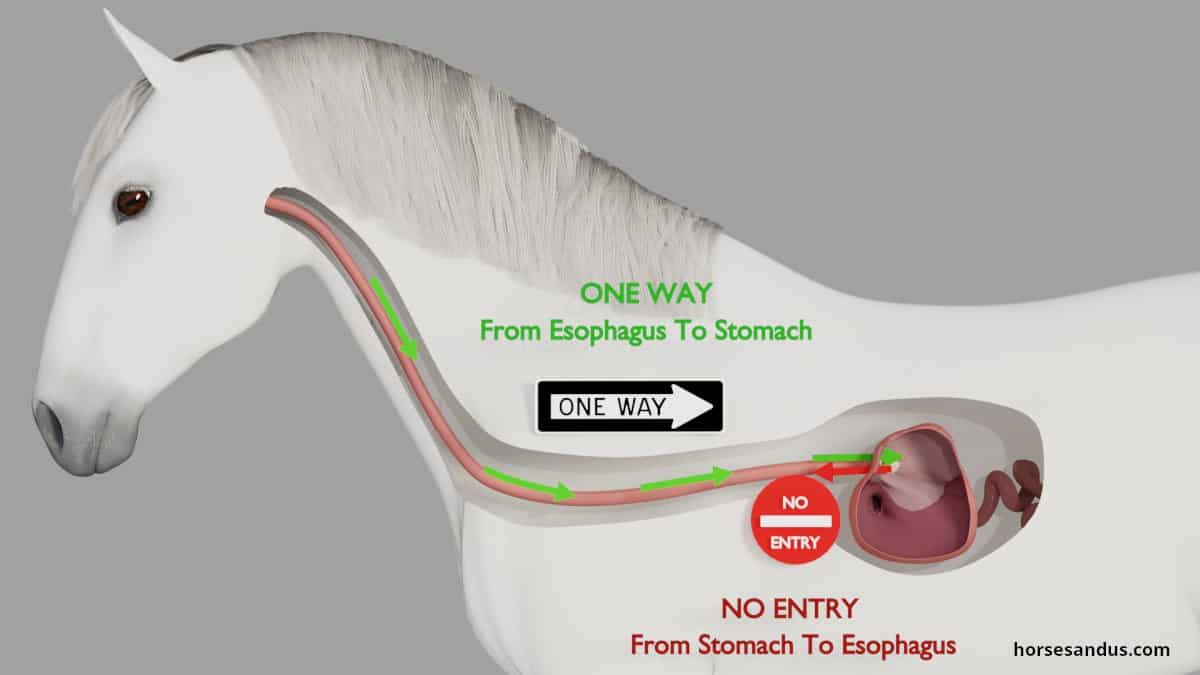We all like to give treats to horses, and we usually tend to give them something that we enjoy eating. Everyone loves chocolate, and some of us may want to share this delicious treat with our horses. But can horses eat chocolate?
While we can enjoy chocolate without any problem, horses are not so lucky. They should not eat chocolate because it can be harmful to them. Chocolate or Cacao products may be toxic to horses. When given in high doses, it can even kill them.
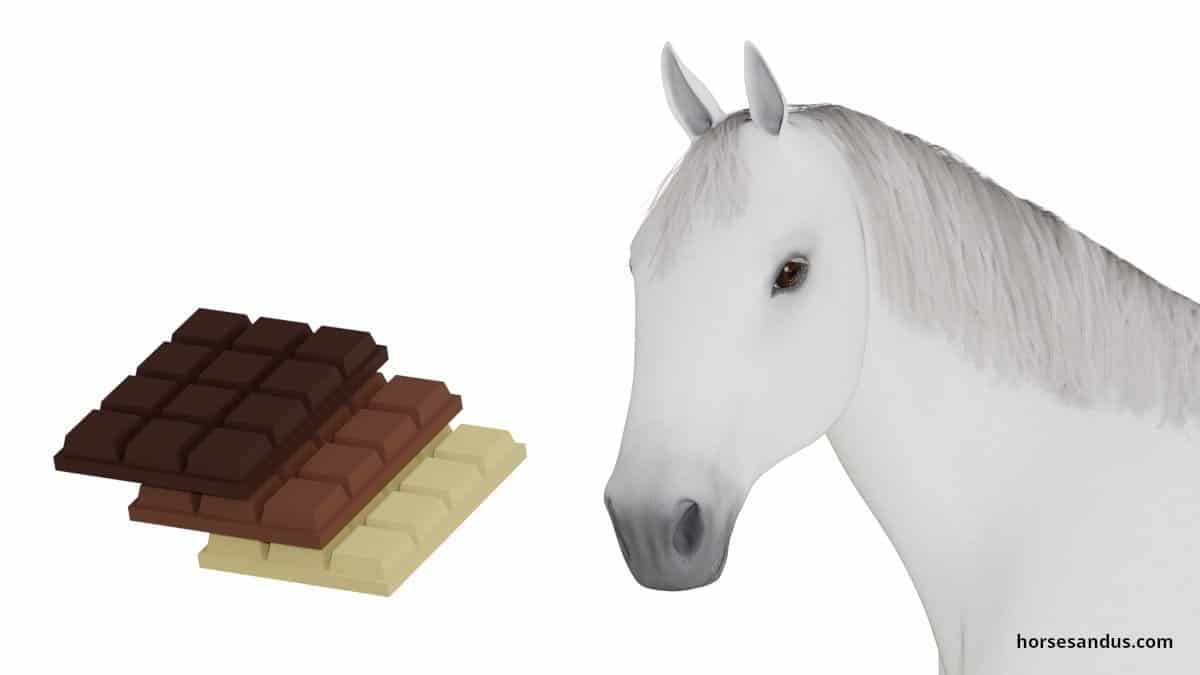
Would you like to know why ? Read on to find out.
Why Can’t Horses Eat Chocolate?
Chocolate contains caffeine and theobromine. These substances are from the same family and have adverse physiological effects on horses.
Some people think that it is the caffeine contained in chocolate that is dangerous. But although caffeine can have adverse effects on horses, it exists in small quantities in chocolate.
Theobromine Is The Real Problem With Chocolate
The real problem is Theobromine because it exists in higher quantities in chocolate. Adding to that, it is a metabolite of caffeine, i.e., caffeine is metabolized into theobromine in the horse’s body.

Theobromine has physiological effects on horses. Specifically, it stimulates the heart and is a blood vessel dilator.
In humans, theobromine gets metabolized quickly. It does not stay in the body long enough to cause any harm. Also, if we eat too much chocolate and feel sick, we can expel it by vomiting.
But horses are not so lucky. They cannot vomit, and they metabolize theobromine much more slowly. It can remain in their bloodstream for many hours. Therefore theobromine will build up to toxic levels in the horse’s body and cause severe health problems.
Symptoms Caused by Eating Chocolate
The severity of the symptoms depends on how much chocolate the horse has has eaten and the type of chocolate.
The symptoms vary from mild to severe:
- Small amounts of chocolate produce mild effects. But even small amounts can be detected in the horse’s urine during anti-doping drug tests for competition horses.
- Large amounts of chocolate produce more severe effects, which can be: metabolic derangement, colic, heart attacks, seizures, and internal bleeding.
- Consuming large amounts of chocolate over time can even kill a horse. There are known cases of chocolate toxicity leading to the death of horses. But these occur during cocoa farming, where horses have access to large quantities of raw chocolate. Which they can eat freely, and thus suffer fatal consequences.
Sources Of Theobromine
Horses can ingest theobromine coming from different sources. It can come directly from chocolate snacks or from Cacao by-products that are added to their feed and bedding.
Theobromine from Chocolate Snacks
Horses will eat chocolate if we give it to them. Theobromine can get into the horse’s body just by feeding him a chocolate snack. Usually, a small amount of chocolate, especially milk chocolate or white chocolate, will not do much harm. But we should avoid it because it can have adverse effects.
Instead, we should offer other harmless treats like carrots or apples that horses love and are healthy for them.
Theobromine from Cacao by-products

Cacao by-products such as cacao pod husks, cacao bean shells, cacao bean meal, and waste from chocolate industries are all potential nutritive resources added to animal feed.
Cacao by-products in animal feed has economic benefits:
- It can replace expensive conventional feed resources.
- It can provide a solution to waste management problems associated with cacao processing factories.
- It Increases animal productivity and reduces the cost of animal production.
Cacao by-products such as bean shells are also a potential alternative to conventional bedding material such as sawdust or straw.
However, the use of these by-products is severely restricted by theobromine, which is toxic to livestock.
Compared to other animals, dogs and horses seem to be far more sensitive to theobromine’s adverse effects.
Feed manufacturers will recognize the toxicity of theobromine to horses. So those that operate under strict quality control standards will not include cacao by-products in feeds for horses.
Are All Types Of Chocolate Equally Harmful To Horses?
Horses can eat different types of chocolate. Each type will have different amounts of theobromine, so their toxicity levels are not the same, and therefore they are not equally harmful.
Theobromine Content in Chocolate
In general, the darker the chocolate, the more theobromine it will have.
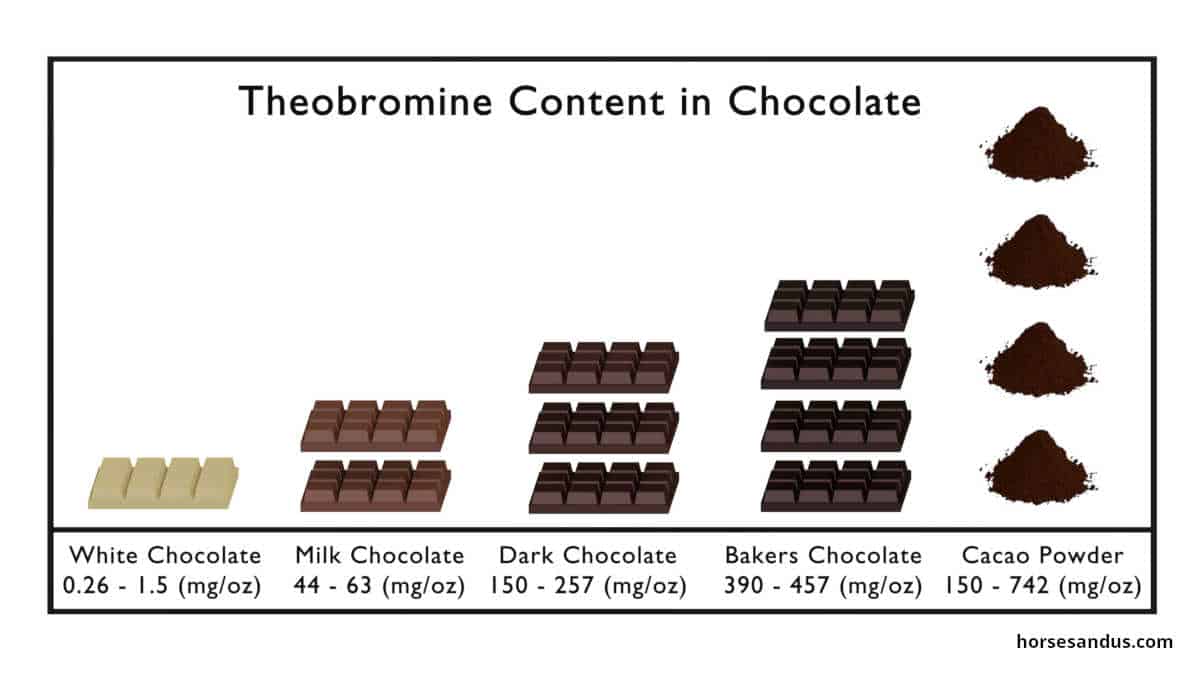
source of this data.
Theobromine Content in Cacao By-products
The highest quantity of theobromine is concentrated in the cacao bean. The pod husk and bean shell have lower quantities.

source of this data.
Theobromine and Caffeine are Prohibited in Competition Horses
If your horse is competing, you must ensure he does not have any substance prohibited by Equestrian Sports Federations like FEI.
Caffeine and theobromine are banned in equine sports competitions because they are believed to enhance a horse’s performance. If a horse tests positive for these substances, it can be disqualified. Since chocolate contains these substances, feeding it to competition horses should definitely be avoided.
If a horse just eats a chocolate snack, you may think this is not enough to detect prohibited substances in an anti-doping test. But you may be surprised to find out that it actually can.
Anti-doping Tests Can detect chocolate from M&Ms
An unusual situation occurred to a racehorse in Florida. Caffeine and theobromine were detected in the horse’s urine. This was a result of being fed M&M’s chocolate-coated peanuts for some days before the anti-doping tests were taken.
Because of this case, research was done at Ohio State University. In this study, horses were fed 20 chocolate-coated peanuts every day. After eight days, detectable amounts of caffeine and theobromine were found in their urine.
These amounts are enough to disqualify a horse from the competition. However, they are probably not enough to give the horse any competitive advantage.
Anti-Doping Tests Can Detect Cocoa From horse Feeds and Bedding
Caffeine and theobromine can also inadvertently get into the horse’s body by coming from other sources such as cocoa by-products that may exist in horse feeds and bedding.
So it would be best if you were careful only to buy horse feeds from reputable manufacturers who operate under strict quality control standards.
Besides caffeine and theobromine being toxic to horses and having adverse health effects, there is also the additional risk that horses with these substances may be disqualified from equestrian competitions.
These reasons are more than enough to avoid feeding chocolate or other cacao products to horses.
Finally let´s take a quick look at how chocolate is made.
How is Chocolate Made ?
Chocolate is produced from cacao beans that grow in trees called Theobroma Cacao.
In fact, the name Theobromine derives from Theobroma, which itself derives from the Greek words theo (“god”) and broma (“food”), meaning “food of the gods.”
To obtain chocolate, the cacao beans need to go through a long process with several steps:

- Plantation – Cacao beans are the seeds of the fruit that is produced by cacao trees. These trees are called Theobroma Cacao.
- Harvest – The Cacao pods are cut from the tree when they are mature.
- Extraction – The mass of beans surrounded by pulp is scooped from the cacao pod. The cacao husks are by-products of this step.
- Fermentation – The beans with the pulp are heaped in piles and covered to allow the fermentation of the pulp, leaving just the beans in the end.
- Drying – The beans are laid out to dry naturally in the sun or in sheds
- Roasting – The beans are then roasted, which causes the beans to expand and burst the outside thin shell.
- Winnowing – The shells are winnowed away with fans leaving behind the broken bits of beans called cacao nibs. The cacao bean shells are by-products of this step.
- Grinding – The nibs are crushed into a paste, then heated and melted into a liquid called cacao liquor. When cooled, this product hardens into a solid mass.
- Pressing – The cacao liquor is then pressed to separate the cacao butter from the cacao solids. The cacao solids are then further pressed into cakes and pulverized into cacao powder.
- Mixing – The different ingredients: chocolate liquor, cacao butter, sugar, and milk are mixed. The mix of ingredients depends on the type of chocolate: dark, milk, or white.
- Conching – The liquid chocolate is stirred at high temperatures to develop the flavor and release bitterness.
- Molding – The chocolate is finally poured into molds to form bars or specialized retail products. The confectionary leftovers are by-products of this step.
Further reading
If you would like to learn more on this subject, you may want to check following links.
Exploration of Cacao by-products
Chocolate treats bad for horses
